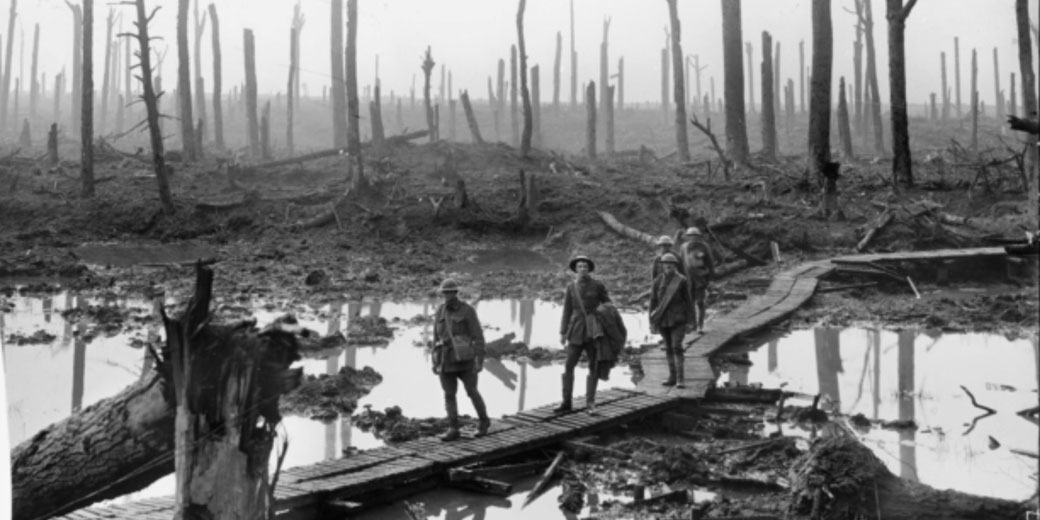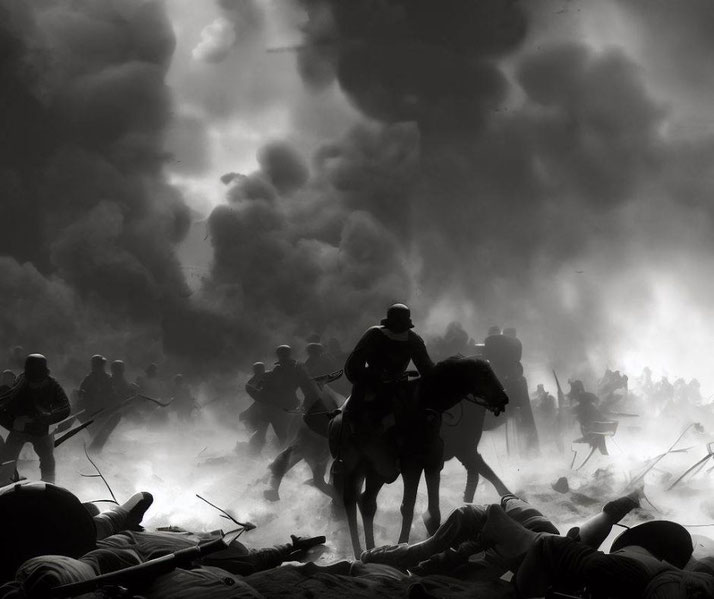Passchendaele: Understanding the carnage of World War One's most infamous battle

World War One, also known as the Great War, was a war of unprecedented scale and devastation. It saw the dramatic introduction of many new technologies that would change the nature of military conflict forever.
Among the many battles that marked this catastrophic period in human history, the Battle of Passchendaele is consistently remembered as one of the most destructive.
Known officially as the Third Battle of Ypres, this event has become synonymous with the very worst of trench warfare conditions: from the weather, the death toll, and the unrelenting suffering experienced by those involved.
What was the Battle of Passchendaele?
The Battle of Passchendaele was fought between July and November of 1917. It would become one of the longest, bloodiest, and most controversial battles of the First World War.
The campaign, planned by the British under the command of Sir Douglas Haig, was intended to break through the German lines by capturing the ridge around the ruined city of Ypres, Belgium.
Why did the battle occur?
The year was 1917, and the Great War was in its third gruelling year. On the Western Front, the war had been mired in a bloody stalemate.
Both sides were dug into an elaborate network of trenches that stretched across the landscape from the Swiss border to the North Sea.
The Battle of Passchendaele was a new attempt by the Allies to regain momentum and, hopefully, bring about a decisive victory.
The geopolitical significance of Passchendaele lay in its strategic location: it was situated on high ground overlooking the city of Ypres.
Capturing this site from the Central Powers would give the Allies both a commanding view of the surrounding region and also serve to protect the channel ports, which were vital lifelines for Britain.
Furthermore, it would divert German attention away from the French, who were recovering from the devastating losses of the Nivelle Offensive and a number of crippling mutinies.
The Allies, primarily represented by British and Dominion forces, were led by Field Marshal Sir Douglas Haig.
Haig was a career soldier and wholeheartedly believed in the power of the offensive; he held an unwavering conviction that breakthrough was possible despite the evidence of previous costly failures.
On the other side, the Central Powers were principally represented by the German Fourth Army, under the command of Crown Prince Rupprecht of Bavaria.
These German troops held a deeply entrenched defensive position, which was bolstered by concrete pillboxes, machine gun nests, and a considerable artillery presence.
Planning and preparation for mass slaughter
Haig's offensive plan, titled the Ypres-Passchendaele operation, was designed as a step-by-step operation.
The ultimate objective was to capture the high ground at Passchendaele, but Haig also hoped to exploit the initial gains with a rapid advance that would break the German lines.
However, the defensive preparations of the Central Powers were equally meticulous.
Knowing the importance of Passchendaele Ridge, the German army had set up their artillery well behind their frontline to ensure that it would survive the initial bombardment.
The key events of the Battle of Passchendaele
The battel finally began on July 31, 1917. This is when the British completed a two-week-long bombardment using approximately 4.5 million shells, hoping to soften the German defenses.
This initial phase, however, was less successful than hoped. The German troops, well-protected in their concrete bunkers, largely survived the artillery barrage.
The first major phase of the subsequent ground offensive, the Battle of Pilckem Ridge, commenced on July 31.
Initial progress was promising, with British and allied forces capturing a portion of the ridge.
However, the advance slowed down due to the onset of heavy rain, turning the churned-up battlefield into a quagmire.
The second phase, the Battle of Langemarck, took place in mid-August. Despite the weather slightly improving, the mud still significantly hampered progress.
The British gains were minimal and costly. Also, the Germans launched successful counterattacks, further nullifying the Allied advance.
The third phase, known now as the Battle of Menin Road, began on September 20.
This was part of a new shift in British strategy to a 'bite and hold' approach. This concept attempted to secure smaller but more manageable gains, which proved to be successful.
The battles of Polygon Wood and Broodseinde soon followed, continuing the 'bite and hold' strategy and resulting in important, albeit costly, territorial gains.

The Battle of Poelcapelle, which commenced in early October, saw a return to notorious heavy rains.
Once more, relentlessly muddy conditions severely hampered the British advance.
The final phase took place in late October and early November.
Once more, these assaults aimed to capture the village of Passchendaele itself. The First Battle saw minimal gains at a heavy cost, but the Second Battle, on November 6, resulted in the capture of the village by Canadian forces.
After more than three months of bitter fighting, the Battle of Passchendaele ultimately came to an end.
The ridge had been captured, but at a tremendous cost. The subsequent winter would make the gains almost impossible to hold.
The nightmarish conditions of the battlefield
The conditions on the battlefield during the Battle of Passchendaele were among the most horrific of World War One.
In many ways, the battle is remembered more for the environmental challenges the soldiers faced than for the tactical maneuvers or strategic objectives.
One of the most dominant features of the battle was the mud. Heavy rains, combined with the shell-pocked landscape, resulted in a battlefield that was virtually a sea of mud.
The thick mud not only made movement extremely difficult but also swallowed up men, horses, and equipment.
Living conditions for the soldiers were as equally abysmal. The trenches, typically a place of relative safety, were waterlogged and often collapsed.
Often, this left the exhausted soldiers exposed to enemy fire.
Many accounts from soldiers at this time talk about how much sleep was a luxury.
Any food the army supplied was often cold and unappetizing, not to mention the constant threat of disease, such as trench foot, caused by the damp conditions.
What made it worse was the fact that medical care during the battle was also a significant challenge.
The sheer number of casualties overwhelmed the medical services.
Many wounded soldiers could not be moved due to the mud and were left exposed to the elements and enemy fire.
When mixed with the lack of sanitation and the presence of rats and lice, there was a dramatic increase in the risk of infection.

How many people were killed at Passchendaele?
The human toll of the Battle of Passchendaele is staggering to comprehend, even more than a century later.
Exact numbers vary, but it is generally accepted that the Allies suffered between 200,000 and 245,000 casualties.
A significant portion of these were fatalities.
The German casualties were similarly high, with estimates ranging between 200,000 and 400,000.
It was the extensive use of artillery, the prevalence of machine-gun fire, and the introduction of mustard gas by the Germans all contributed to the incredibly high casualty rate.
Perhaps most horrifying was the manner in which many of these casualties occurred.
Many soldiers were not simply killed by gunfire or explosions, but drowned in the mud or succumbed to exposure and disease.
Others were left wounded on the battlefield, unable to be retrieved due to the unyielding mire and the constant threat of enemy fire.
These men often suffered agonizing deaths over hours or even days.
Moreover, the battle had a profound effect on the home fronts. The sheer scale of the casualties, and the stark descriptions of the conditions sent home by the soldiers, shook public morale in Britain, Canada, Australia, New Zealand, and other contributing nations.
The war had already been going on for three years, and the grim news from Passchendaele only served to deepen the sense of war-weariness and disillusionment.
What happened after the battle?
The Battle of Passchendaele ended officially on November 10, 1917, with the capture of Passchendaele village by Canadian forces.
The Allies had secured the high ground, and the German U-boat bases on the Belgian coast, the original strategic objective, were now within reach.
These gains were difficult to consolidate due to the onset of winter, and much of the captured ground would be lost in the German Spring Offensive of 1918.
The high casualty rate, combined with the minimal territorial gains, led to intense scrutiny and criticism of the leadership, particularly of Sir Douglas Haig.
The senseless loss of life for such negligible gain led many to view Passchendaele as a symbol of the futile and indiscriminate slaughter of trench warfare.
What do you need help with?
Download ready-to-use digital learning resources
Copyright © History Skills 2014-2024.
Contact via email
With the exception of links to external sites, some historical sources and extracts from specific publications, all content on this website is copyrighted by History Skills. This content may not be copied, republished or redistributed without written permission from the website creator. Please use the Contact page to obtain relevant permission.





